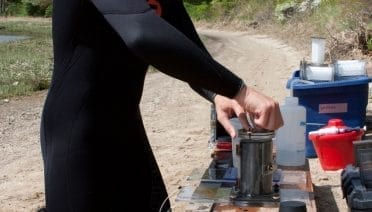Press Room
The Woods Hole Oceanographic Institution (WHOI) and the Consortium for Ocean Leadership (OL) announced Teledyne Webb Research, of East Falmouth, Mass., will provide open ocean gliders supporting the Coastal and Global Scale Nodes (CGSN) component of the Ocean Observatories Initiative…
On June 10, the Woods Hole Oceanographic Institution (WHOI) hosted a visit from Admiral Gary Roughead, the Chief of Naval Operations, marking the first such appearance by a serving Chief of Naval Operations.
The Woods Hole Oceanographic Institution (WHOI) will lead the first international, multidisciplinary assessment of the levels and dispersion of radioactive substances in the Pacific Ocean off the Fukushima nuclear power plant—a research effort funded by the Gordon and Betty Moore Foundation.
JapanÃÂs recent magnitude 9.0 earthquake, which triggered a devastating tsunami, relieved stress along part of the quake fault but also has contributed to the build up of stress in other areas, putting some of the country at risk for up to years of sizeable aftershocks and perhaps new main shocks, scientists say.
The Woods Hole Oceanographic Institution (WHOI) will host a public forum on May 25 from 2 p.m. to 5 p.m. in Redfield Auditorium on the theme ÃÂÃÂThe Seafood Dilemma: Does it Matter Where We Get Our Seafood? The Balance of US Production, Imports, Wild Capture, and Aquaculture in US Seafood Supply.ÃÂÃÂ
Kakani Katija, a postdoctoral scholar at Woods Hole Oceanographic Institution (WHOI), has been selected as one of 14 National Geographic Emerging Explorers for 2011 for her investigation into the role swimming animals might play in mixing and moving the oceans and other large bodies of water.
One year after the explosion of the Deepwater Horizon drilling platform in the northern Gulf of Mexico, the Woods Hole Oceanographic Institution (WHOI) is unveiling a new multimedia website, Science in a Time of Crisis.
Researchers from Woods Hole Oceanographic Institution (WHOI) and their colleagues have discovered that massive, swirling ocean eddiesÂknown to be up to 500 kilometers across at the surfaceÂcan reach all the way to the ocean bottom at mid-ocean ridges, some 2,500 meters deep, transporting tiny sea creatures, chemicals, and heat from hydrothermal vents over large distances.
WHOIÃÂs Mark Baumgartner finds that the location, the length of stay, and perhaps the very abundance of the whales may be dependent on an interesting vertical migration pattern by the copepods on which the whales feed. It seems to be a case, he said, of ÃÂhow the behavior of the prey influences the behavior of the whales.ÃÂ
Scientists from the NOAA-funded Gulf of Maine Toxicity (GOMTOX) project issued an outlook for a moderate regional bloom of a toxic alga that can cause ‘red tides’ in the spring and summer of this year, potentially threatening the New England…
A search team led by the Woods Hole Oceanographic Institution (WHOI) has located the wreckage of Air France Flight 447 some 3,900 meters, or nearly 2.5 miles, below the surface of the Atlantic Ocean off Brazil’s northeastern coast.
Warmer air is only part of the story when it comes to Greenland’s rapidly melting ice sheet. New research by scientists at Woods Hole Oceanographic Institution (WHOI) highlights the role ocean circulation plays in transporting heat to glaciers. Greenland’s ice…
The Woods Hole Oceanographic Institution (WHOI) is again teaming with French authorities to renew the international search for the deep-sea wreck site of Air France Flight 447 and to retrieve the flight recorders from the Airbus A 330.
An international team of researchers reports in a paper led by WHOI’s Peter Tyack the first data on how beaked whales respond to naval sonar exercises. Their results suggest that sonar indeed affects the behavior and movement of whales.
An oceanographer may be offering the best explanation yet of one of the great mysteries of flighthow albatrosses fly such vast distances, even around the world, almost without flapping their wings. The answer, says Philip L. Richardson of the Woods Hole Oceanographic Institution (WHOI), lies in a concept called dynamic soaring, in which the large bird utilizes the power of above-ocean wind shear while tacking like an airborne sailboat.
The Woods Hole Oceanographic Institution (WHOI) and the Consortium for Ocean Leadership (OL) announced Teledyne Webb Research, of East Falmouth, Mass., will provide coastal gliders supporting the Pioneer and Endurance Arrays of the Coastal and Global Scale Nodes (CGSN) for…
A three-year study into the cause of local area red tides is set to begin March 21. A team of researchers from the National Park Service, U.S. Geological Survey, and Woods Hole Oceanographic Institution will be examining the cause of…
While JapanÃÂÃÂÃÂÃÂÃÂÃÂÃÂÃÂs 9.0-magnitude earthquake and accompanying tsunami represent a devastating natural disaster for the countryÃÂÃÂÃÂÃÂÃÂÃÂÃÂÃÂs residents, scientists should also seize upon the massive temblor as an important learning tool for future quakes around the world, including the Pacific Northwest coast of the United States, according to experts from the Woods Hole Oceanographic Institution (WHOI).
The Woods Hole Oceanographic Institution (WHOI) ranked second of the ten best places to work for postdoctoral researchers, according to a 2011 survey by the magazine The Scientist. The rankings included 76 US institutions.
With a mission of exploring the potential impact of iron fertilization of the oceans to reduce the amount of carbon dioxide (CO2) in the Earth’s atmosphere, Woods Hole Oceanographic Institution (WHOI) Senior Scientist Ken Buesseler has helped lead the organization…


